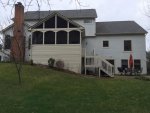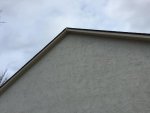cuisinartoh
Member
I've spent the last 5 days since my post asking for radio advice reading up on all the recommendations for HT and mobile recommendations. I'm taking a break from that and pondering my feed line routing, antenna mounting, and antenna options. I am newly licensed for GMRS and studying for my tech class amateur license.
I attached pictures of the back of my house for reference and the gable end of the far right side. My office and "radio room" is the room on the far right, first story, above the windows in the basement. I can relatively easily get some LMR-400 to the far right gable end of the roof over the office. With some extra effort, I think I can get some LMR-400 to the far right gable end of the of the upper roof. This neighborhood is governed by an HOA and while there is no specific prohibition against antennas, there is a default provision that states anything attached to the house is subject to approval. I get it and I understand. So, with this background, I'll ask my questions.
Question 1:
For my purposes, I think it makes sense to consider mounting a dedicated UHF antenna for GMRS on the lower, far right of the roof. Since I don't want complaints, I'm thinking a commercial (as in purchased) omni is is a good idea since this antenna will be the most visible. Can anyone recommend a good commercial antenna for my base use with GMRS frequencies?
Question 2:
How do you recommend I mount the antenna? We get the occasional gusty winds here and three years ago we had strong enough straight-line winds that got me a new roof.
Question 3:
I'm not sure how to ground the mast of this antenna. My TV antenna is on the chimney so running a ground was easy. With the roof edge mount, I don't know how to ground the mast without running a ground wire along the roof and down to the ground. That might look ugly. Any thoughts? I am assuming running a mast ground inside the house and bonding it to the ground in my electrical system would be bad. I can't get a ground wire from these locations all the way back to the earth ground where my panel is. But I can get to a 12 gauge or 16 gauge ground in an electrical box in the attic. I think I could even fish down to bond to a water line in the garage.
Question 4:
Do you have a recommendation for a good commercial 2m/70cm antenna? It'll mount pretty much the same way as the GMRS antenna (on the edge of the upper roof) but this antenna won't be nearly as visible. I think an omni antenna here would be best too. I've seen some Comet fiberglass whips with short ground plane radials that seems visually unobtrusive.
Question 5:
Do I ground the coax through a lightening/surge arrestor outside near the mast or inside the house? If inside the house, can I ground it house wiring ground?
Question 6:
Since LMR-400 is so darned stiff, I'm thinking of terminating the feed lines to a wall plate with bulk heads (assuming this is a good idea). Can I then use a short length of more flexible coax from the radio to the wall plate with bulk head? If so, what would you recommend here?
Question 7:
If I'm asking questions that are too obvious and you can point me to a book for newbies that addresses all of these, please point me in the right direction.
Again, thank you all for any advice you have. I wasn't sure where to post this question since it covers both amateur and GMRS antenna questions. If I posted to the wrong forum then please let me know.
I attached pictures of the back of my house for reference and the gable end of the far right side. My office and "radio room" is the room on the far right, first story, above the windows in the basement. I can relatively easily get some LMR-400 to the far right gable end of the roof over the office. With some extra effort, I think I can get some LMR-400 to the far right gable end of the of the upper roof. This neighborhood is governed by an HOA and while there is no specific prohibition against antennas, there is a default provision that states anything attached to the house is subject to approval. I get it and I understand. So, with this background, I'll ask my questions.
Question 1:
For my purposes, I think it makes sense to consider mounting a dedicated UHF antenna for GMRS on the lower, far right of the roof. Since I don't want complaints, I'm thinking a commercial (as in purchased) omni is is a good idea since this antenna will be the most visible. Can anyone recommend a good commercial antenna for my base use with GMRS frequencies?
Question 2:
How do you recommend I mount the antenna? We get the occasional gusty winds here and three years ago we had strong enough straight-line winds that got me a new roof.
Question 3:
I'm not sure how to ground the mast of this antenna. My TV antenna is on the chimney so running a ground was easy. With the roof edge mount, I don't know how to ground the mast without running a ground wire along the roof and down to the ground. That might look ugly. Any thoughts? I am assuming running a mast ground inside the house and bonding it to the ground in my electrical system would be bad. I can't get a ground wire from these locations all the way back to the earth ground where my panel is. But I can get to a 12 gauge or 16 gauge ground in an electrical box in the attic. I think I could even fish down to bond to a water line in the garage.
Question 4:
Do you have a recommendation for a good commercial 2m/70cm antenna? It'll mount pretty much the same way as the GMRS antenna (on the edge of the upper roof) but this antenna won't be nearly as visible. I think an omni antenna here would be best too. I've seen some Comet fiberglass whips with short ground plane radials that seems visually unobtrusive.
Question 5:
Do I ground the coax through a lightening/surge arrestor outside near the mast or inside the house? If inside the house, can I ground it house wiring ground?
Question 6:
Since LMR-400 is so darned stiff, I'm thinking of terminating the feed lines to a wall plate with bulk heads (assuming this is a good idea). Can I then use a short length of more flexible coax from the radio to the wall plate with bulk head? If so, what would you recommend here?
Question 7:
If I'm asking questions that are too obvious and you can point me to a book for newbies that addresses all of these, please point me in the right direction.
Again, thank you all for any advice you have. I wasn't sure where to post this question since it covers both amateur and GMRS antenna questions. If I posted to the wrong forum then please let me know.



